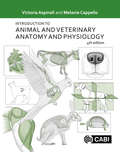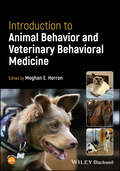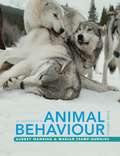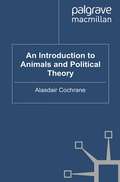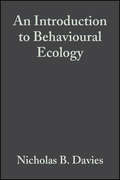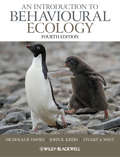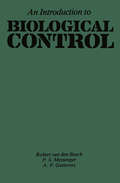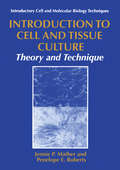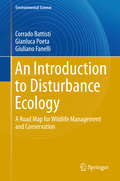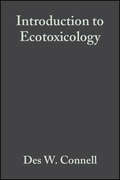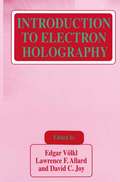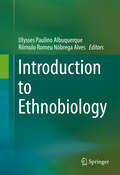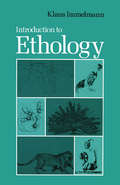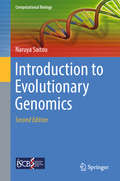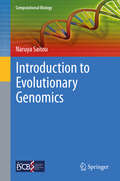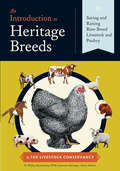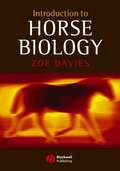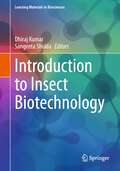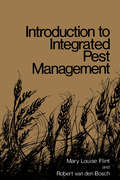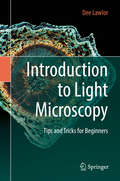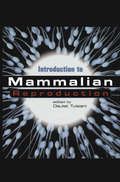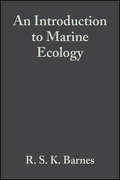- Table View
- List View
Introduction to Animal and Veterinary Anatomy and Physiology
by Victoria Aspinall BVSc, MRCVS Melanie Cappello BSc (Hons) ZooloA sound knowledge of anatomy and physiology is an essential basis for the effective clinical treatment of companion animals and farm animals alike. The fourth edition of this bestselling book continues to provide a comprehensive description of the anatomy and physiology of dogs and cats. The book builds on these foundations with detailed descriptions of exotic small species including birds, and domestic farm animals, including cows, sheep and pigs, as well as the horse. The text: Contains detailed descriptions of the systematic anatomy and physiology of a wide range of animal species. Covers clinical conditions and disease examples related to the individual body systems. Includes applied anatomy tips that relate theory to clinical practice. Is written by expert authors with a wealth of veterinary, animal science and teaching experience. Includes more clinical application examples and question and answer tests to reinforce student learning. Has been updated with more information for animal science students. This text provides an essential basis for all those embarking upon a veterinary, animal science or animal management career.
Introduction to Animal Behavior and Veterinary Behavioral Medicine
by Meghan E. HerronIntroduction to Animal Behavior and Veterinary Behavioral Medicine Understand and apply key concepts of animal behavior in veterinary practice Animal behavior is a critical aspect of veterinary medicine, often underappreciated despite its pervasiveness throughout the field. Understanding animal behavior can facilitate communication with patients, refine diagnoses and indications of ill health, and aid in processes of learning and socialization. Introduction to Animal Behavior and Veterinary Behavioral Medicine offers a comprehensive overview of the key concepts underlying the behavior of multiple animal species before demonstrating how to apply these concepts clinically. The result is an indispensable resource for veterinary students and practitioners who want to deepen their understanding of patient needs. Introduction to Animal Behavior and Veterinary Behavioral Medicine readers will also find: Comprehensive coverage of companion animal behavior and additional coverage of livestock and wild animal behavior Detailed discussion of topics including social development, animal learning, and applied behavior analysis In depth review of diagnosis and treatment strategies for common behavior disorders in companion animals, extending to various additional species Companion website with videos, handouts for downloading, and links to pertinent scientific articles and informative websites Introduction to Animal Behavior and Veterinary Behavioral Medicine is ideal preparation for veterinary medical students as part of “day one readiness” in their professional careers, as well as veterinary practitioners looking for a solid foundation in animal behavior and the treatment of key issues.
Introduction to Animal Behavior and Veterinary Behavioral Medicine
by Meghan E. HerronIntroduction to Animal Behavior and Veterinary Behavioral Medicine Understand and apply key concepts of animal behavior in veterinary practice Animal behavior is a critical aspect of veterinary medicine, often underappreciated despite its pervasiveness throughout the field. Understanding animal behavior can facilitate communication with patients, refine diagnoses and indications of ill health, and aid in processes of learning and socialization. Introduction to Animal Behavior and Veterinary Behavioral Medicine offers a comprehensive overview of the key concepts underlying the behavior of multiple animal species before demonstrating how to apply these concepts clinically. The result is an indispensable resource for veterinary students and practitioners who want to deepen their understanding of patient needs. Introduction to Animal Behavior and Veterinary Behavioral Medicine readers will also find: Comprehensive coverage of companion animal behavior and additional coverage of livestock and wild animal behavior Detailed discussion of topics including social development, animal learning, and applied behavior analysis In depth review of diagnosis and treatment strategies for common behavior disorders in companion animals, extending to various additional species Companion website with videos, handouts for downloading, and links to pertinent scientific articles and informative websites Introduction to Animal Behavior and Veterinary Behavioral Medicine is ideal preparation for veterinary medical students as part of “day one readiness” in their professional careers, as well as veterinary practitioners looking for a solid foundation in animal behavior and the treatment of key issues.
An Introduction To Animal Behaviour (400MB+ File Request)
by Aubrey Manning Marian Stamp Dawkins400MB+ File Request. Wolves excitedly greet each other as members of the pack come together; a bumble bee uses its long tongue to reach the nectar at the base of a foxglove flower; a mongoose swiftly and deftly bites its prey to death; young cheetahs rest quietly together, very close to sleep. Now in full colour, this revised and updated edition of Manning and Dawkins' classic text provides a beautifully written introduction to the fundamentals of animal behaviour. Tinbergen's four questions of causation, evolution, development and function form the fundamental framework of the text, illustrated with fascinating examples of complex behavioural mechanisms. The authors provide accounts of all levels of behaviour from the nerve cell to that of the population. The strengths of An Introduction to Animal Behaviour as a textbook include its clear explanations and concise, readable text and the enthusiasm of the authors for their subject.
An Introduction To Animals And Political Theory (The\palgrave Macmillan Animal Ethics Ser. )
by Alasdair CochraneStructured around the five most important schools within contemporary political theory: liberalism, utilitarianism, communitarianism, Marxism and feminism, this is the first introductory level text to offer an accessible overview on the status of animals in contemporary political theory.
An Introduction To Animals And Political Theory (The\palgrave Macmillan Animal Ethics Ser. )
by Alasdair CochraneStructured around the five most important schools within contemporary political theory: liberalism, utilitarianism, communitarianism, Marxism and feminism, this is the first introductory level text to offer an accessible overview on the status of animals in contemporary political theory.
An Introduction to Behavioural Ecology
by Nicholas B. Davies John R. KrebsThe third edition of this successful textbook looks again at the influence of natural selection on behavior - an animal's struggle to survive by exploiting resources, avoiding predators, and maximizing reproductive success. In this edition, new examples are introduced throughout, many illustrated with full color photographs. In addition, important new topics are added including the latest techniques of comparative analysis, the theory and application of DNA fingerprinting techniques, extensive new discussion on brood parasite/host coevolution, the latest ideas on sexual selection in relation to disease resistance, and a new section on the intentionality of communication. Written in the lucid style for which these two authors are renowned, the text is enhanced by boxed sections illustrating important concepts and new marginal notes that guide the reader through the text. This book will be essential reading for students taking courses in behavioral ecology. The leading introductory text from the two most prominent workers in the field. Second colour in the text. New section of four colour plates. Boxed sections to ilustrate difficult and important points. New larger format with marginal notes to guide the reader through the text. Selected further reading at the end of each chapter.
An Introduction to Behavioural Ecology
by Nicholas B. Davies John R. Krebs Stuart A. WestThis textbook helped to define the field of Behavioural Ecology. In this fourth edition the text has been completely revised, with new chapters and many new illustrations and full colour photographs. The theme, once again, is the influence of natural selection on behaviour – an animal's struggle to survive and reproduce by exploiting and competing for resources, avoiding predators, selecting mates and caring for offspring, – and how animal societies reflect both cooperation and conflict among individuals. Stuart A. West has joined as a co-author bringing his own perspectives and work on microbial systems into the book. Written in the same engaging and lucid style as the previous editions, the authors explain the latest theoretical ideas using examples from micro-organisms, invertebrates and vertebrates. There are boxed sections for some topics and marginal notes help guide the reader. The book is essential reading for students of behavioural ecology, animal behaviour and evolutionary biology. Key Features: Long-awaited new edition of a field-defining textbook New chapters, illustrations and colour photographs New co-author Focuses on the influence of natural selection on behavior, and how animal societies reflect both cooperation and conflict among individuals “The long-awaited update to a classic in this field is now here, presenting new directions in thinking and addressing burning questions. Richly informed by progress in many other disciplines, such as sensory physiology, genetics and evolutionary theory, it marks the emergence of behavioural ecology as a fully fledged discipline….. This is a marvellous book, written in a lucid style. A must-read for those in the field, it is also a cornucopia of new thinking for anyone interested in evolution and behaviour.” Manfred Milinski, Nature, 2012
An Introduction to Behavioural Ecology
by Nicholas B. Davies John R. Krebs Stuart A. WestThis textbook helped to define the field of Behavioural Ecology. In this fourth edition the text has been completely revised, with new chapters and many new illustrations and full colour photographs. The theme, once again, is the influence of natural selection on behaviour – an animal's struggle to survive and reproduce by exploiting and competing for resources, avoiding predators, selecting mates and caring for offspring, – and how animal societies reflect both cooperation and conflict among individuals. Stuart A. West has joined as a co-author bringing his own perspectives and work on microbial systems into the book. Written in the same engaging and lucid style as the previous editions, the authors explain the latest theoretical ideas using examples from micro-organisms, invertebrates and vertebrates. There are boxed sections for some topics and marginal notes help guide the reader. The book is essential reading for students of behavioural ecology, animal behaviour and evolutionary biology. Key Features: Long-awaited new edition of a field-defining textbook New chapters, illustrations and colour photographs New co-author Focuses on the influence of natural selection on behavior, and how animal societies reflect both cooperation and conflict among individuals “The long-awaited update to a classic in this field is now here, presenting new directions in thinking and addressing burning questions. Richly informed by progress in many other disciplines, such as sensory physiology, genetics and evolutionary theory, it marks the emergence of behavioural ecology as a fully fledged discipline….. This is a marvellous book, written in a lucid style. A must-read for those in the field, it is also a cornucopia of new thinking for anyone interested in evolution and behaviour.” Manfred Milinski, Nature, 2012
An Introduction to Biological Control
by A.P. Gutierrez P.S. Messenger R. van den BoschThis volume is a revision of Biological Control by R. van den Bosch and P. S. Messenger, originally published by Intext Publishers. In the revision, I have attempted to keep the original theme, and to update it with current research findings and new chapters or sections on insect pathology, microbial control of weeds and plant pathogens, population dynamics, integrated pest management, and economics. The book was written as an undergraduate text, and not as a complete review of the subject area. Various more comprehen sive volumes have been written to serve as handbooks for the experts. This book is designed to provide a concise overview of the complex and valuable field of biological control and to show the relationships to the developing concepts of integrated pest management. Population regulation of pests by natural enemies is the major theme of the book, but other biological methods of pest control are also discussed. The chapter on population dynamics assumes a precalculus-level knowledge of mathematics. Author names of species are listed only once in the text, but all are listed in the Appendix. Any errors or omissions in this volume are my sole responsibility. A. P. Gutierrez Professor of Entomology Division of Biological Control University of California, Berkeley vii Acknowledgments Very special thanks must be given to my colleagues, Professors C. B. Huffaker and L. E. Caltagirone, for the very thorough review they provided and for the many positive suggestions they gave. Dr.
Introduction to Cell and Tissue Culture: Theory and Technique (Introductory Cell and Molecular Biology Techniques)
by Jennie P. Mather Penelope E. RobertsIt is a pleasure to contribute the foreword to Introduction to Cell and Tissue Culture: The ory and Techniques by Mather and Roberts. Despite the occasional appearance of thought ful works devoted to elementary or advanced cell culture methodology, a place remains for a comprehensive and definitive volume that can be used to advantage by both the novice and the expert in the field. In this book, Mather and Roberts present the relevant method ology within a conceptual framework of cell biology, genetics, nutrition, endocrinology, and physiology that renders technical cell culture information in a comprehensive, logical for mat. This allows topics to be presented with an emphasis on troubleshooting problems from a basis of understanding the underlying theory. The material is presented in a way that is adaptable to student use in formal courses; it also should be functional when used on a daily basis by professional cell culturists in a- demia and industry. The volume includes references to relevant Internet sites and other use ful sources of information. In addition to the fundamentals, attention is also given to mod ern applications and approaches to cell culture derivation, medium formulation, culture scale-up, and biotechnology, presented by scientists who are pioneers in these areas. With this volume, it should be possible to establish and maintain a cell culture laboratory devot ed to any of the many disciplines to which cell culture methodology is applicable.
An Introduction to Disturbance Ecology: A Road Map for Wildlife Management and Conservation (Environmental Science and Engineering)
by Corrado Battisti Gianluca Poeta Giuliano FanelliThis book represents an introductory review of disturbance ecology and threat analysis, providing schematic concepts and approaches useful for work on sites that are affected by the impact of human actions. It is aimed at conservation and environmental practitioners, who will find tips for choosing methods and approaches when there are conflicts between the natural components and human activity. It is also addressed to students of applied ecology, ecosystem management, land-use planning and environmental impact assessment. It discusses a number of topics covered in the programs of many university courses related to basic ecology and ecology of disturbance, the latter constituting a field of great interest because of its implications and repercussions in applied territorial science. The book is divided into two parts: the first focuses on the theoretical and disciplinary framework of the ecology of disturbance, while the second is devoted to the analysis of anthropogenic threats. This, in particular, discusses the most recent approach, which uses a conventional nomenclature to allow a coarse-grained quantification and objective assessment of threat impact on different environmental components. Such an approach facilitates the comparison of hierarchically different events and, therefore, helps define the priorities for management and conservation strategies.
Introduction to Ecotoxicology
by Des W. Connell Paul Lam Bruce Richardson Rudolf WuEnvironmental pollution is one of the most serious threats to the future health of our planet. A wide and ever increasing range of chemicals from industry, agriculture, medicine and a host of other sources continue to contribute to the earth's chemical load. Governments have encountered great difficulties responding to the crucial and immediate need for effective management. As a result, the new science of ecotoxicology has developed, which provides a broad conceptual framework for evaluating the effects of chemicals in natural ecosystems. This book is aimed principally at undergraduate students who have completed basic courses in both chemistry and biology. It takes a broad view of ecotoxicology starting with the nature, properties and behaviour of environmental toxicants, and extends to dose/response relationships and effects on organisms, populations, communities and ecosystems. Importantly, it also addresses environmental management areas such as biomarkers, biomonitoring, ecological risk assessment and the ecotoxicology and management of chemicals. The book provides an invaluable overview of the subject for students taking courses in ecotoxicology and environmental pollution, as well as wider degree programmes in biology, ecology, wildlife management, environmental science, environmental impact assessment, toxicology, pollution, chemical engineering, civil engineering, sanitation engineering and related subjects.
Introduction to Electron Holography
by Edgar Völkl Lawrence F. Allard David C. JoyExperienced and novice holographers receive a solid foundation in the theory and practice of holography, the next generation of imaging technology, in this superb text. The book's `how to' aspects enable readers to learn hologram acquisition at the microscope and processing of holograms at the computer as well as digital imaging techniques. A complete bibliography on electron holography and applications of the method to problems in materials science, physics and the life sciences round out the volume's coverage.
Introduction to Ethnobiology
by Ulysses Paulino Albuquerque Rômulo Romeu Nóbrega AlvesThis textbook provides a basic introduction to ethnobiology with key concepts for beginners. It is also written for those who teach ethnobiology or related fields. The core issues and concepts, as well as approaches and theoretical positions are fully covered.
Introduction to Ethology
by Klaus ImmelmannEthology, the study of the biology of behavior, has grown tremendously during the last few decades. The large number of accumulated facts is difficult to survey, understanding and an appreciation of the ethological approach to the study of behavior have grown, and the number of attempts at holistic explanations for certain behavioral phenomena has increased. Because of this development it has become more difficult to gain an overview of the field, to keep up with new developments, and to update the subject matter by the inclusion of new facts in the proper place. The nonspecialist is unable to evaluate the more general statements in the popular literature, especially when such works are aimed at a broader audience. Hence, this book has a dual purpose: (1) to lend some order to the dizzying array of information and thus simplify inquiry into ethology; and (2) to present relevant facts and knowledge that will help the reader confronted with numerous studies and articles in the ethological literature.
Introduction to Evolutionary Genomics (Computational Biology #Vol. 17)
by Naruya SaitouThis authoritative textbook/reference presents a comprehensive introduction to the field of evolutionary genomics. The opening chapters describe the fundamental concepts in molecular biology and genome evolution for readers without any prior background in this area. This is followed by a detailed examination of genome evolution in various different groups of organisms. The text then concludes with a review of practical methods essential to researchers in the field.This updated and revised new edition also features historical perspectives on contributions to evolutionary genomics from related fields such as molecular evolution, genetics, and numerical taxonomy.Topics and features: introduces the basics of molecular biology, covering protein structure and diversity, as well as DNA replication, transcription, and translation; examines the phylogenetic relationships of DNA sequences, and the processes of mutation, neutral evolution, and natural selection; presents a brief evolutionary history of life, surveying the key features of the genomes of prokaryotes, eukaryotes, viruses and phages, vertebrates, and humans; reviews the various biological “omic” databases, and discusses the analysis of homologous nucleotide and amino acid sequences; provides an overview of the experimental sequencing of genomes and transcriptomes, and the construction of phylogenetic trees; describes methods for estimating of evolutionary distances, and performing studies of population genetics; supplies additional supporting material at an associated website.Serving as an indispensable textbook for graduate and advanced undergraduate courses on evolutionary genomics, this accessible overview will also prove invaluable to researchers from both computer science and the biological sciences seeking a primer on the field.
Introduction to Evolutionary Genomics (Computational Biology #17)
by Naruya SaitouThis book is the first of its kind to explain the fundamentals of evolutionary genomics. The comprehensive coverage includes concise descriptions of a variety of genome organizations, a thorough discussion of the methods used, and a detailed review of genome sequence processing procedures. The opening chapters also provide the necessary basics for readers unfamiliar with evolutionary studies. Features: introduces the basics of molecular biology, DNA replication, mutation, phylogeny, neutral evolution, and natural selection; presents a brief evolutionary history of life from the primordial seas to the emergence of humans; describes the genomes of prokaryotes, eukaryotes, vertebrates, and humans; reviews methods for genome sequencing, phenotype data collection, homology searches and analysis, and phylogenetic tree and network building; discusses databases of genome sequences and related information, evolutionary distances, and population genomics; provides supplementary material at an associated website.
An Introduction to Heritage Breeds: Saving and Raising Rare-Breed Livestock and Poultry
by D. Phillip Sponenberg DVM Jeannette Beranger Alison MartinThis inviting, visual guide to the world of heritage livestock explains why conserving heritage breeds is important, how to raise the profiled species (including chickens, turkeys, ducks, geese, rabbits, pigs, sheep, goats, cattle, donkeys, and horses), and who are the people working to preserve these breeds.
Introduction to Horse Biology
by Zoe DaviesMany students have only a limited knowledge of biology before starting a variety of equine courses, from BHS stages to National Certificate and Diploma and HND/degree. Introduction to Horse Biology provides all the information students of equine subjects require, particularly those without a GCSE or A level in biology. This book will be invaluable to all students of equine subjects including First Diploma, National Diploma, National Certificate, Higher National Diploma and Higher National Certificate and all students studying for BHS or other equine related examinations. It is also ideal for serious horse owners searching for a better understanding of horses and how they function. The Author Zoe Davies is a former lecturer in equine science, a consultant equine nutritionist, author and external examiner for higher education courses. She has substantial experience in equine management and training. Also from Blackwell Publishing Horse and Stable Management Fourth Edition Jeremy Houghton Brown, Sarah Pilliner and Zoe Davies 1 4051 0007 9 Horse Nutrition and Feeding Second Edition Sarah Pilliner 0 632 05016 0 Teaching Jumping Jane Houghton Brown 0 632 04127 7 Equine Science Second Edition Sarah Pilliner and Zoe Davies 1 4051 1944 6
Introduction to Insect Biotechnology (Learning Materials in Biosciences)
by Dhiraj Kumar Sangeeta ShuklaThis textbook introduces to the fundamentals and applications of insect biotechnology in a concise manner. Global economically important insects such as silkworm, lac or honey bee are in the focus of this text. The book attempts to address all of the latest developments in this growing field such as application of metagenomics and proteomics in mining for genes and enzymes that could be beneficial in diverse industrial and biomedical applications. Further, insects have been established as suitable tool for the production of transgenic products which is discussed in one dedicated chapter. The book targets students and researchers in molecular biology, biotechnology or entomology who want to get familiar with the emerging field of insect biotechnology.
Introduction to Integrated Pest Management
by M.L. Flint R. van den BoschIntegrated control of pests was practiced early in this century, well before anyone thought to call it "integrated control" or, still later, "integrated pest management" (IPM), which is the subject of this book by Mary Louise Flint and the late Robert van den Bosch. USDA entomologists W. D. Hunter and B. R. Coad recommended the same principles in 1923, for example, for the control of boll weevil on cotton in the United States. In that program, selected pest-tolerant varieties of cotton and residue destruction were the primary means of control, with insecticides consid ered supplementary and to be used only when a measured incidence of weevil damage occurred. Likewise, plant pathologists had also developed disease management programs incorporating varietal selection and cul tural procedures, along with minimal use of the early fungicides, such as Bordeaux mixture. These and other methods were practiced well before modern chemical control technology had developed. Use of chemical pesticides expanded greatly in this century, at first slowly and then, following the launching of DDT as a broadly successful insecticide, with rapidly increasing momentum. In 1979, the President's Council on Environmental Quality reported that production of synthetic organic pesticides had increased from less than half a million pounds in 1951 to about 1.4 billion pounds-or about 3000 times as much-in 1977.
Introduction to Light Microscopy: Tips and Tricks for Beginners
by Dee LawlorThis book offers a beginner’s guide to using light microscopes. It begins with a brief introduction to the physics of optics, which will give the reader a basic grasp of the behaviors of light. In turn, each part of the microscope is explained using clear and simple English, together withdetailed photographs and diagrams. The reader will learn the function, care and correct use of each part. A troubleshooting section also helps resolve some of the most common issues encountered in light microscopy. Most people have a general idea of how to use a microscope, but many never get the full benefit, because they receive no training. With easy-to-follow steps and detailed images, this guide will help everyone achieve the best results, and be confident using their microscope. This book is intended for anyone using a light microscope, such as university students, people in lab environments, hobbyists, educators who teach science to young children, and anyone with a general interest in these valuable tools.
Introduction to Mammalian Reproduction
by Daulat TulsianiIntroduction to Mammalian Reproduction is a welcome contribution to the fields of gametogenesis, gamete transport, fertilization, and reproduction technologies. Key topics covered include: *formation and maturation of male gametes; *morphology and physiology of female gametes; *how the sperm meets the egg; *sperm-egg fusion, egg activation, and implantation of fertilized egg; *assisted reproduction and environmental chemicals that have an effect on formation and function of male and female gametes. This book is for both researchers and students involved in reproductive biology.
An Introduction to Marine Ecology
by R. S. Barnes R. N. HughesThis established textbook continues to provide a comprehensive and stimulating introduction to marine ecological concepts and processes. Based on a wealth of international teaching expertise, An Introduction to Marine Ecology is written to be the basis for an entire undergraduate course in marine biology or ecology. It covers the trophic, environmental and competitive interactions of marine organisms, and the effects of these on the productivity, dynamics and structure of marine systems. The strength of the book lies in its discussion of core topics which remains at the heart of the majority of courses in the subject, despite an increasing emphasis on more applied aspects. The authors maintain the tradition of clarity and conciseness set by previous editions, and the text is extensively illustrated with colour plates, photographs and diagrams. Examples are drawn from all over the world. In this edition, the scientific content of the text has been fully revised and updated. An emphasis has been placed on human impacts, and completely new chapters have been added on fisheries, marine ecosystems, and human interference and conservation. Completely revised and updated with a twofold increase in the number of illustrations. Adopts a more applied approach in keeping with current teaching. New chapters on fisheries, the marine ecosystem, conservation and pollution. Based on a proven and successful course structure.
